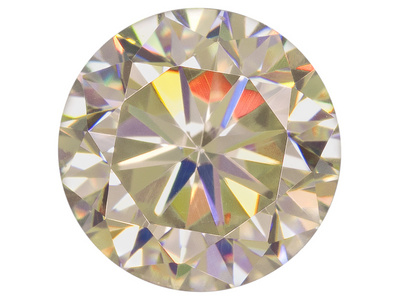From the second half of the 1900s, there was a parade of diamond simulants in the jewelry market. Some made it successful. Some disappeared as suddenly as they appeared.
Synthetic rutile
Synthetic rutile served briefly as a diamond simulant but it’s no longer produced. It can possibly be found in some estate jewelry. One drawback of synthetic rutile as a diamond simulant is its low hardness – it quickly shows signs of wear.
It’s pretty easy to tell synthetic rutile and diamond apart because by appearance, synthetic rutile has a very artificial look with lots of colored fire. Synthetic rutile has one of the highest RI and dispersion than any material, way above that of diamond. Even with unaided eyes, its rainbow colors are so obvious it can detract from its already good brilliance. Besides, synthetic rutile has a yellowish body color that is not easily disguised. Under magnification, synthetic rutile will show double images of its opposite facets as it is a doubly refractive stone, whilst diamond is singly refractive.
Strontium Titanate
Strontium Titanate was developed in the 1950s as a simulant. It was fairly attractive because it is colorless and singly refractive like diamond. However, due to its low hardness, it was too soft and brittle to be used in jewelry, especially rings.
Image credit: JTV
Apart from being a simulant, strontium titanate has also been used as a base for assembled stone fused with a sapphire or spinel crown. These days, strontium titanate is still produced for industrial uses, but its use as a diamond simulant has declined greatly.
Interestingly, long after its heyday as a diamond simulant, the natural form of strontium titanate, mineral tausonite, was found in 1982.

